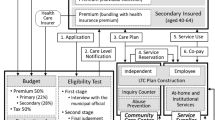Abstract
In private long-term care insurance markets, moral hazard is central to pricing and long-run robustness of the market, yet there is remarkably little evidence on the extent to which moral hazard is present in long-term care insurance. We use Health and Retirement Study data from 1996 to 2014 to assess moral hazard in nursing home and home care use in private long-term care insurance, employing a combination of propensity score matching and instrumental variables approaches. We find evidence of significant moral hazard in home care use and a potentially meaningful but noisy effect on nursing home use. Policymakers designing incentives to promote private long-term care insurance should consider the consequences of moral hazard.
Similar content being viewed by others
Notes
Starting with the 194,269 observations in waves 3 to 12, 9124 observations were dropped due to Veterans Administration coverage. Among the remaining observations, 17,024 observations were dropped due to Medicaid; 5560 observations were dropped due to age; 3637 observations were dropped due to missing LTCI status; 55,454 observations were dropped due to missing lagged tax itemisation status; 0 observations were dropped due to negative income; 13,929 observations were dropped due to negative financial assets; 489 observations were dropped due to negative total assets; and 5288 observations were dropped due to more than USD 2 M total assets.
Total household income includes individual earnings, household capital income, pensions, Social Security Disability Insurance payments, retirement income, unemployment/workers’ compensation, government transfers, and other income. Household financial assets include net value of stocks, mutual funds, investment trusts, bonds and bond funds, bank accounts, certificates of deposit, Treasury bills, and government bonds less debt.
References
Baiocchi, M., D.S. Small, S. Lorch, and P.R. Rosenbaum. 2010. Building a stronger instrument in an observational study of perinatal care for premature infants. Journal of the American Statistical Association 105 (492): 1285–1296. https://doi.org/10.1198/jasa.2010.ap09490.
Basu, A., and N.B. Coe. 2017. 2SLS vs 2SRI: Appropriate methods for rare outcomes and/or rare exposures. Health Economics. https://doi.org/10.1002/hec.3490.
Bernard, D.M., J.S. Banthin, and W.E. Encinosa. 2009. Wealth, income, and the affordability of health insurance. Health Affairs (Millwood) 28 (3): 887–896.
Brown, J.R., N.B. Coe, and A. Finkelstein. 2007. Medicaid crowd-out of private long-term care insurance demand: Evidence from the health and retirement survey. NBER Working Paper Series #10989.
Brown, J.R., and A. Finkelstein. 2008. The interaction of public and private insurance: Medicaid and the long-term care insurance market. American Economic Review 98 (3): 1083–1102.
CDC. 2003. Public health and aging: Trends in aging—United States and worldwide. http://www.cdc.gov/mmwr/preview/mmwrhtml/mm5206a2.htm.
Courtemanche, C., and D. He. 2009. Tax incentives and the decision to purchase long-term care insurance. Journal of Public Economics 93 (2): 296–310.
Cramer, A.T., and G.A. Jensen. 2006. Why don’t people buy long-term-care insurance? Journals of Gerontology Series B 61 (4): 185–193.
Efron, B. 1981. Nonparametric estimates of standard error—the jackknife, the bootstrap and other methods. Biometrika 68 (3): 589–599. https://doi.org/10.1093/biomet/68.3.589.
Eiken, S., K. Sredl, B. Burwell, and P. Saucier. 2016. Medicaid expenditures for long-term services and supports (LTSS) in FY 2014: Managed LTSS reached 15 percent of LTSS spending.
Finkelstein, A., and K. McGarry. 2006. Multiple dimensions of private information: Evidence from the long-term care insurance market. American Economic Review 96 (4): 938–958.
Genworth Financial. 2017. Annual cost of care 2016.
Goda, G.S. 2011. The impact of state tax subsidies for private long-term care insurance on coverage and Medicaid expenditures. Journal of Public Economics 95 (7): 744–757. https://doi.org/10.1016/j.jpubeco.2010.11.001.
Goda, G.S., E. Golberstein, and D.C. Grabowski. 2011. Income and the utilization of long-term care services: Evidence from the social security benefit notch. Journal of Health Economics 30 (4): 719–729. https://doi.org/10.1016/j.jhealeco.2011.04.001.
Grabowski, D.C. 2004. The admission of blacks to high-deficiency nursing homes. Medical Care 42 (5): 456–464.
Grabowski, D.C., and J. Gruber. 2007. Moral hazard in nursing home use. Journal of Health Economics 26 (3): 560–577.
Holm, E., and A. Tergesen. 2010. MetLife steps back from long-term care market. Wall Street Journal. November 12, 2010.
Kane, R.A., R.L. Kane, and R.C. Ladd. 1998. The heart of long-term care. New York: Oxford University Press.
Karlsson, M., L. Mayhew, and B. Rickayzen. 2007. Long term care financing in four OECD countries: Fiscal burden and distributive effects. Health Policy 80 (1): 107–134. https://doi.org/10.1016/j.healthpol.2006.02.002.
Keele, L., and J.W. Morgan. 2016. How strong is strong enough? Strengthening instruments through matching and weak instrument tests. Annals of Applied Statistics 10 (2): 1086–1106. https://doi.org/10.1214/16-AOAS932.
Konetzka, R.T. 2014. Long-term care insurance. In Encyclopedia of Health Economics, ed. A.J. Culyer, 152–159. San Diego: Elsevier.
Konetzka, R.T., and R.M. Werner. 2009. Disparities in long-term care: Building equity into market-based reforms. Medical Care Research and Review. 66 (5): 491–521.
Li, Y., and G.A. Jensen. 2011. The impact of private long-term care insurance on the use of long-term care. Inquiry: The Journal of Health Care Organization, Provision, and Financing 48 (1): 34–50.
McCall, N., S. Mangle, E. Bauer, and J. Knickman. 1998. Factors important in the purchase of partnership long-term care insurance. Health Services Research 33 (2 Pt 1): 187–203.
Mellor, J.M. 2001. Long-term care and nursing home coverage: are adult children substitutes for insurance policies? Journal of Health Economics 20 (4): 527–547.
Mor, V., J. Zinn, J. Angelelli, J.M. Teno, and S.C. Miller. 2004. Driven to tiers: Socioeconomic and racial disparities in the quality of nursing home care. Milbank Quarterly 82 (2): 227–256.
Nyman, J.A. 1988. Excess-demand, the percentage of Medicaid patients, and the quality of nursing-home care. Journal of Human Resources 23 (1): 76–92. https://doi.org/10.2307/145845.
Nyman, J.A. 1999. The economics of moral hazard revisited. Journal of Health Economics 18 (6): 811–824. https://doi.org/10.1016/S0167-6296(99)00015-6.
Nyman, J.A. 2003. The theory of demand for health insurance. Stanford, CA: Stanford University Press.
Nyman, J.A., C. Koc, B.E. Dowd, E. McCreedy, and H.M. Trenz. 2018. Decomposition of moral hazard. Journal of Health Economics 57: 168–178. https://doi.org/10.1016/j.jhealeco.2017.12.003.
Pauly, M.V. 1990. The rational nonpurchase of long-term-care insurance. Journal of Political Economy 98 (1): 153–168.
Sloan, Frank A., and E.C. Norton. 1997. Adverse selection, bequests, crowding out, and private demand for insurance: evidence from the long-term care insurance market. Journal of Risk and Uncertainty 15 (3): 201–219.
Stone, R.I. 2000. Long-term care for the elderly with disabilities: current policy, emerging trends, and implications for the twenty-first century. Milbank Memorial Fund.
Terza, J.V., A. Basu, and P.J. Rathouz. 2008. Two-stage residual inclusion estimation: addressing endogeneity in health econometric modeling. Journal of Health Economics 27 (3): 531–543.
Acknowledgements
We are grateful for funding from the National Institute on Aging, R01AG041108.
Author information
Authors and Affiliations
Corresponding author
Additional information
Publisher's Note
Springer Nature remains neutral with regard to jurisdictional claims in published maps and institutional affiliations.
Rights and permissions
About this article
Cite this article
Konetzka, R.T., He, D., Dong, J. et al. Moral hazard and long-term care insurance. Geneva Pap Risk Insur Issues Pract 44, 231–251 (2019). https://doi.org/10.1057/s41288-018-00119-1
Received:
Accepted:
Published:
Issue Date:
DOI: https://doi.org/10.1057/s41288-018-00119-1






